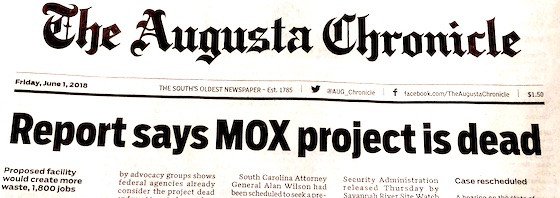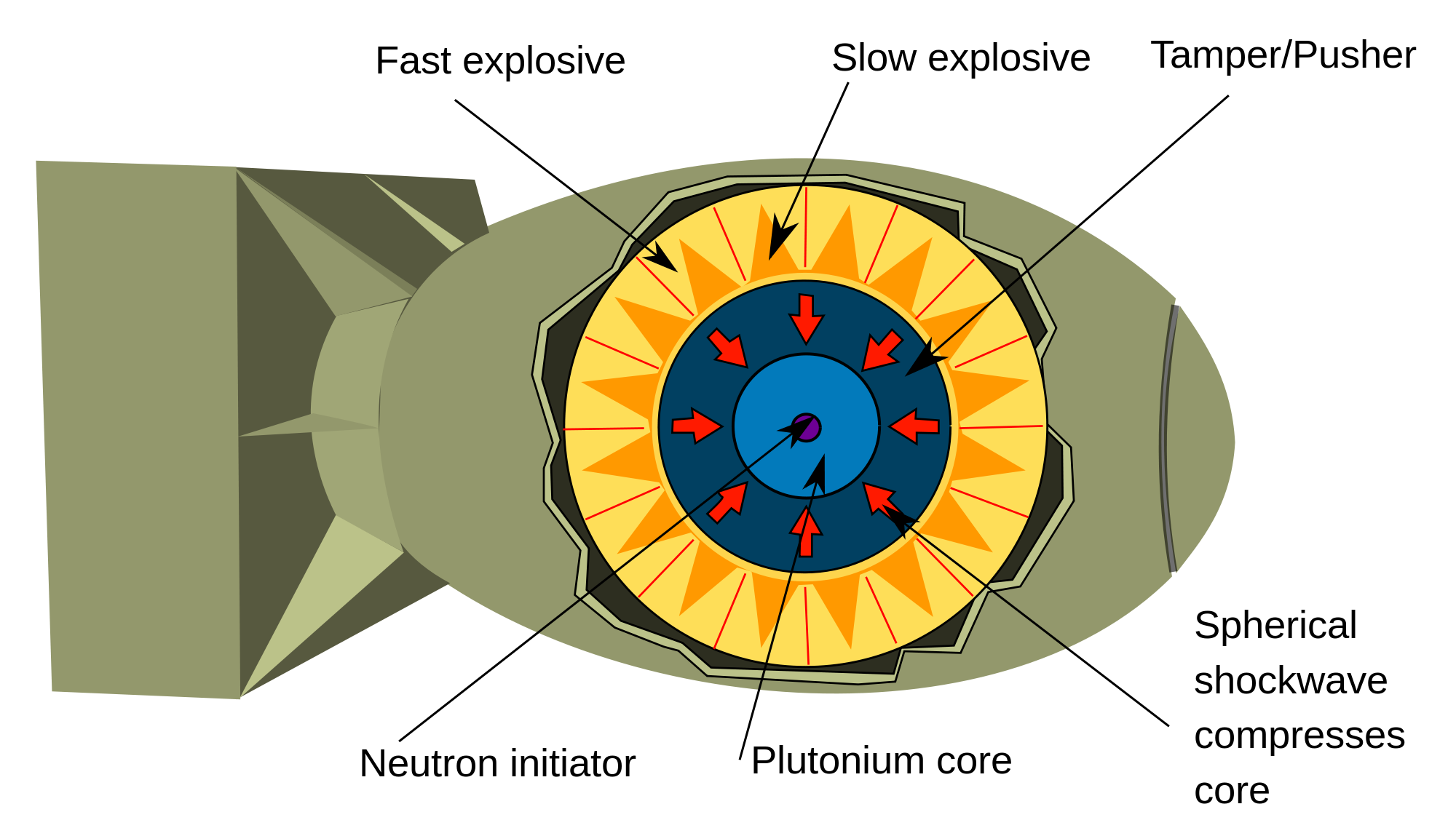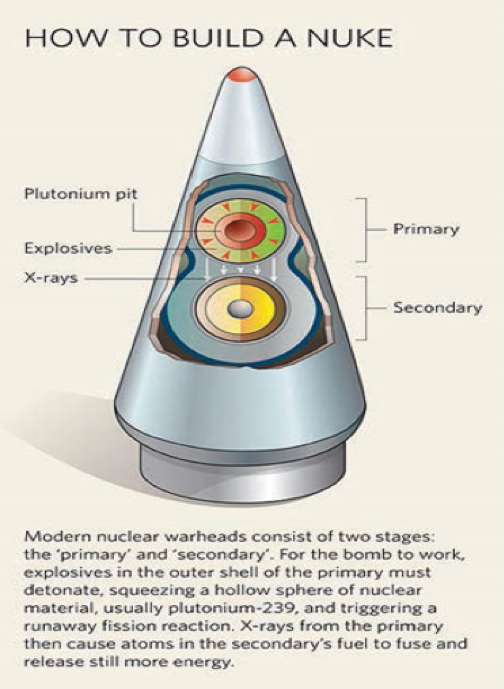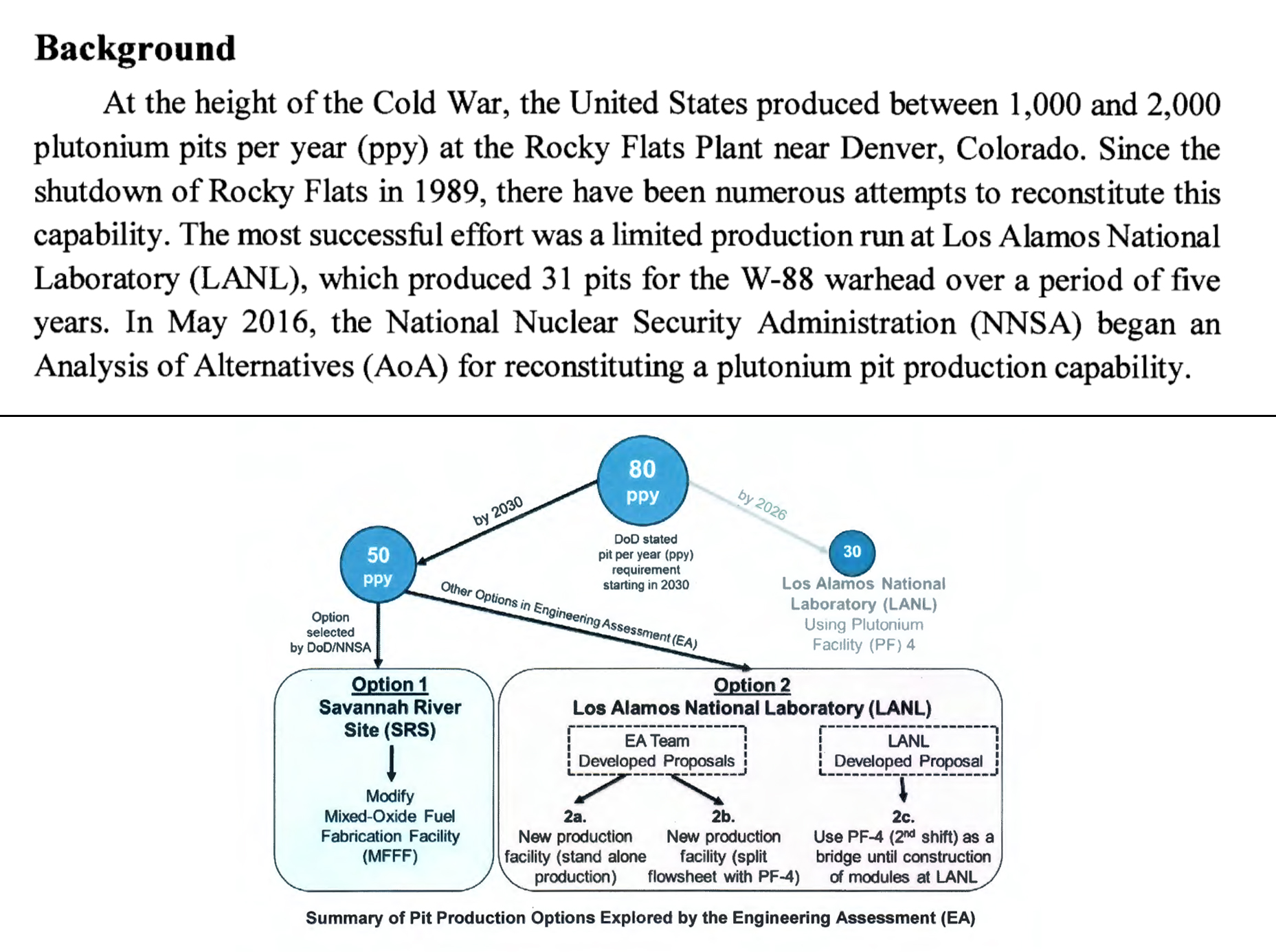Updates
NNSA: Plutonium Pit Production at Both Los Alamos and Savannah River Site
“To achieve DoD’s 80 pits per year requirement by 2030, NNSA’s recommended alternative repurposes the Mixed Oxide Fuel Fabrication Facility at the Savannah River Site in South Carolina to produce plutonium pits while also maximizing pit production activities at Los Alamos National Laboratory in New Mexico. This two-prong approach with at least 50 pits per year produced at Savannah River and at least 30 pits per year at Los Alamos is the best way to manage the cost, schedule, and risk of such a vital undertaking.”
-Joint Statement from Ellen M. Lord and Lisa E. Gordon-Hagerty on Recapitalization of Plutonium Pit Production
NB: Lisa Gordon-Hagerty is the Administrator of the NNSA (National Nuclear Security Administration); Ellen Lord is a DOD Under-secretary and Chair of the Nuclear Weapons Council (Gordon-Hagerty is also an NWC member).
NNSA Proposal to Raise Plutonium Limit Ten-Fold in Los Alamos’ Rad Lab Is First Step in Expanded Plutonium Pit Production: Environmental Assessment Is Premature and Deceptive By Omission
“NNSA should begin a nation-wide review of plutonium pit production, why it’s needed, and what it will cost the American taxpayer in financial, safety and environmental risks. These are all things that the public should know.”
– Jay Coghlan, Director, Nuclear Watch New Mexico.
NNSA Releases Draft Environmental Assessment for LANL Rad Lab; Raises Plutonium Limit 10 Times for Expanded Pit Production
Santa Fe, NM.
Today the National Nuclear Security Administration announced an Environmental Assessment to increase the amount of plutonium used in the Radiological Laboratory Utility and Office Building (aka the “Rad Lab”) at the Los Alamos National Laboratory from 38.6 grams of plutonium-239 equivalent to 400 grams. This 10-fold increase is significant because it will dramatically expand materials characterization and analytical chemistry capabilities in the Rad Lab in support of expanded plutonium pit production for future nuclear weapons designs. It also re-categorizes the Rad Lab from a “radiological facility” to a “Hazard Category-3” nuclear facility.
Santa Fe City Council: LANL Cleanup Order Must Be Strengthened and Expanded and Plutonium Pit Production Suspended Until Safety Issues Are Resolved
Santa Fe, NM.
On the evening of Wednesday October 25, the Santa Fe City Council passed a resolution requesting that the New Mexico Environment Department strengthen the revised Los Alamos National Labs cleanup order to call for additional characterization of legacy nuclear wastes, increased cleanup funding, and significant additional safety training. The resolution also called for the suspension of any planned expanded plutonium pit production until safety issues are resolved.
Expanded Plutonium Pit Production at LANL Will Not Result in Significant Positive Effect On Job Creation and the Regional Economy
The National Nuclear Security Administration’s own documents have explicitly stated that expanded pit production would have no significant positive effect on job creation and the regional economy of northern New Mexico. Nuclear Watch argues that expanded plutonium pit production could actually have negative effect if it blocks other economic alternatives such as comprehensive cleanup, which could be the real job producer.Continue reading
Expanded Plutonium Pit Production at LANL Will Not Result in Significant Positive Effect On Job Creation and the Regional Economy
Abstract: Expanded production of plutonium pits, the fissile cores of modern thermonuclear weapons, is cynically being justified as a source of job creation. Precise data on employment in plutonium pit production at the Los Alamos National Laboratory (LANL) and the number of additional jobs if expanded is not publicly available to our knowledge. However, the National Nuclear Security Administration’s own documents quoted below explicitly state that expanded pit production would not have any significant positive effect on job creation and the regional economy of northern New Mexico. Further, Nuclear Watch argues that expanded plutonium pit production could actually have negative effect if expanded pit production blocks other economic alternatives such as comprehensive cleanup, which could be the real job producer. Moreover, given LANL’s poor safety and environmental record, expanded plutonium pit production could have a seriously negative economic effect on northern New Mexico in the event of any major accidents or additional contamination.
Final Supplemental Environmental Impact Statement for the Nuclear Facility Portion of the Chemistry and Metallurgy Research Building Replacement Project at Los Alamos National Laboratory, Los Alamos, New Mexico
https://energy.gov/nepa/eis-0350-s1-supplemental-environmental-impact-statement-nuclear-facility-portion-chemistry-and
Bolded emphasis added
Note: The CMRR-Nuclear Facility was the up to $6.5 billion dollar plutonium facility NNSA proposed to build at LANL in direct support of expanded plutonium pit production. The Obama Administration cancelled it in 2012 after costs rose so high. Nevertheless, the 2011 CMRR-Nuclear Facility supplemental environmental impact statement remains the most relevant source of publically available socioeconomic information concerning expanded plutonium pit production that we know of.
Volume 1, p. 2-43, Socioeconomics
…
Under the Modified CMRR-NF Alternative, an increase in construction-related jobs and businesses in the region surrounding LANL is also expected. Construction employment would be needed over the course of a 9-year construction period under either the Deep or Shallow Excavation Option. Construction employment under either option is projected to peak at about 790 workers, which is expected to generate about 450 indirect jobs in the region. Operation of the Modified CMRR-NF and RLUOB would involve about 550 workers at LANL, with additional workers using the facility on a part-time basis. The personnel working in the Modified CMRR-NF and RLUOB, when fully operational, would relocate from other buildings at LANL, including the existing CMR Building, so an increase in the overall number of workers at LANL is not expected.
Note: The first phase of the Chemistry and Metallurgy Research Replacement Project, the Radiological Laboratory Utility and Office Building (RLUOB), is already built. It is now being retrofitted to handle up to 400 grams of plutonium-239 equivalent instead of the original 8.4 grams. This will greatly increase its special nuclear materials analytical chemistry and materials characterization capabilities in direct support of expanded plutonium pit production.
Under the Continued Use of CMR Building Alternative, about 210 employees would continue to work in the CMR Building until safety concerns force additional reductions in facility operations. In addition, about 140 employees would be employed at RLUOB. A total of about 350 personnel would have their offices relocated to RLUOB. The personnel working in the CMR Building and RLUOB, when fully operational, would not result in an increase in the overall number of workers at LANL.
Pg. 4-12
4.2.9 Socioeconomics
Construction Impacts—Construction of new buildings at TA-55 to house CMR activities would require a peak construction employment level of 300 workers. This level of employment would generate about 852 indirect jobs in the region around LANL. The potential total employment increase of 1,152 direct and indirect jobs represents an approximate 1.3 percent increase in the workforce and would occur over the proposed construction period. This small increase would have little or no noticeable impact on the socioeconomic conditions of the region of influence (ROI).
Operations Impacts—CMRR Facility operations would require a workforce of approximately 550 workers. As evaluated in the CMRR EIS, this would be an increase of about 340 workers over currently restricted CMR Building operational requirements. Nevertheless, the increase in the number of workers in support of expanded CMRR Facility operations would have little or no noticeable impact on socioeconomic conditions in the LANL ROI (region of influence). New LANL employees hired to support the CMRR Facility would compose a small fraction of the LANL workforce and an even smaller fraction of the regional workforce.
4.3.9 Socioeconomics
Construction Impacts – Deep Excavation Option—Construction of the Modified CMRR-NF under the Deep Excavation Option would require a peak construction employment level of about 790 workers (LANL 2011a:Data Call Tables, 002). This level of employment would generate about 450 indirect jobs in the region around LANL. The potential total peak employment of 1,240 direct and indirect jobs represents an increase in the ROI workforce of approximately 0.8 percent. Direct construction employment would average 420 workers annually over this time, approximately half of the estimated peak employment. The average direct construction employment would result in about 240 indirect jobs in the region around LANL. This total of 660 direct and indirect jobs represents an approximate 0.4 percent increase in the ROI workforce. These small increases would have little or no noticeable impact on the socioeconomic conditions of the ROI.
Pg. 4-54
Chapter 4 – Environmental Consequences
Construction Impacts – Shallow Excavation Option—The impacts under the Shallow Excavation Option from construction of the Modified CMRR-NF would be similar to the Deep Excavation Option. The peak employment number of about 790 construction workers would be the same as under the Deep Excavation Option, and the annual average would be 410 workers over the life of the project. The average direct construction employment would result in about 240 indirect jobs in the region around LANL. This total of 650 direct and indirect jobs represents an approximate 0.4 percent increase in the ROI workforce. Therefore, there would be little or no noticeable impact on the socioeconomic conditions of the ROI.
Operations Impacts—Operations at the Modified CMRR-NF and RLUOB would require a workforce of approximately 550 workers, including workers that would come from other locations at LANL to use the Modified CMRR-NF laboratory capabilities. The number of workers in support of Modified CMRR-NF operations would cause no change to socioeconomic conditions in the LANL four-county ROI (region of influence). Workers assigned to the Modified CMRR-NF and RLUOB would be drawn from existing LANL facilities, including the CMR Building. The number of LANL employees supporting the Modified CMRR-NF and RLUOB operations would represent only a small fraction of the LANL workforce (approximately 13,500 in 2010) and an even smaller fraction of the regional workforce (approximately 165,000 in 2010).
Volume 2, p. 2-13: As discussed in this CMRR-NF SEIS, operation of the new CMRR-NF, if built, is not expected to result in any increase in LANL employment. The people expected to work in the new facility would be transferred from other facilities at LANL where CMR-related activities are currently being accomplished (such as the CMR Building).
– End of NNSA quotes –
Note: The CMRR-Nuclear Facility was expected to cost up to $6.5 billion. It’s pathetic that the largest construction project ever in New Mexico (with the exception of the interstate highways) was going to create no new Lab jobs.
Comprehensive cleanup at LANL would be a win-win for northern New Mexicans, permanently protecting the environment while providing hundreds of high paying jobs.
- When DOE wants to do something, it lowballs the cost. When DOE doesn’t want to do something, it highballs the cost. LANL has estimated that comprehensive cleanup of Area G would cost $29 billion. Using actual costs of cleaning up smaller dumps, Nuclear Watch has extrapolated that cleanup of Area G would cost $7 to 8 billion. See https://nukewatch.org/facts/nwd/Area_G_Comparison_Costs-11-14-12.pdf
- But of that $29 billion, DOE estimated that labor costs would be $13 billion. Applying that 45% proportion to Nuclear Watch’s estimate, that would be around $3.5 billion in jobs, jobs that northern New Mexico sorely needs.
- Comprehensive cleanup could be the real job producer. It has the additional advantage of being more conducive to regional economic development in that more locally based contractors could possibly do the cleanup work, instead nuclear weapons work such as expanded plutonium pit production conducted by huge out-of-state defense contractors such as Bechtel and Lockheed Martin.
New nuclear ‘pit’ production at LANL is unnecessary
From the Albuquerque Journal
New nuclear ‘pit’ production at LANL is unnecessary
By Jay Coghlan
Friday, July 21st, 2017 at 12:02am
SANTA FE, N.M. — The Center for Public Integrity recently published a series of articles on nuclear safety lapses in plutonium pit production at the Los Alamos lab that captured a lot of national attention.
Plutonium pits are the fissile cores of nuclear weapons that initiate the thermonuclear detonation of modern weapons. The articles were largely based on the National Nuclear Security Administration’s annual contractor Performance Evaluation Reports. Those reports are publicly available only because Nuclear Watch New Mexico successfully sued for them in 2012.
The former plutonium pit production site, the Rocky Flats Plant near Denver, was shut down by a 1989 FBI raid investigating environmental crimes. A special grand jury indicted both Department of Energy (DOE) officials and the contractor, but a federal judge quashed the indictments at the urging of the local federal attorney general. It was only by sheer luck that a major plutonium fire on Mother’s Day 1969 didn’t contaminate Denver with highly carcinogenic plutonium.
I specifically recall senior DOE officials promising New Mexicans 20 years ago that serious lessons were learned from Rocky Flats and that re-established plutonium pit production at the Los Alamos National Laboratory (LANL) would always be safe. Since then, the lab has spent billions of taxpayers’ money on plutonium pit production but, as the recent articles document, LANL still can’t do it safely.
As the articles reported, a serious nuclear criticality accident was narrowly averted in July 2011, which resulted in the three-year shutdown of LANL’s main plutonium facility. Nevertheless, according to the fiscal year 2011 LANL Performance Evaluation Report, the lab contractor was paid $50 million in pure profit for that year.
In 2014, a radioactive waste barrel improperly prepared by LANL ruptured underground at the Waste Isolation Pilot Plant (WIPP), shutting down that multi-billion-dollar facility for nearly three years. Radioactive waste disposal at WIPP will remain constrained for years, raising the question of where future LANL bomb-making wastes will go.
Congress has required the Los Alamos lab to quadruple plutonium pit production, regardless of the technical needs of the stockpile. The requirement was drafted by professional staff on the House Armed Services Committee, one of whom was originally from the Sandia nuclear weapons lab.
That the existing stockpile doesn’t need pit production is demonstrated by the fact that none has been scheduled since 2011 when LANL finished up the production run that was stopped when Rocky Flats was shut down.
At NukeWatch’s request, former U.S. Sen. Jeff Bingaman (D-NM) required an independent study of the lifetimes of pits. The expert conclusion was that plutonium pits last at least a century, more than double government estimates (the oldest pits in the stockpile are now around 45 years old). Moreover, there are some 20,000 existing plutonium pits stored at the Pantex Plant near Amarillo, Texas.
Future plutonium pit production is for a new so-called “Interoperable Warhead” that is supposed to function both as a land-based ICBM and a sub-launched nuclear warhead. The nuclear weapons labs are pushing this $13 billion make-work project that the Navy doesn’t want.
Ironically, new-design pits for the Interoperable Warhead may hurt national security because they cannot be tested in a full-scale nuclear weapons test or, alternatively, testing them would have severe international proliferation consequences.
Given all this, why expand plutonium pit production when apparently it can’t be done safely and may decrease, not increase, our national security? One strong reason is the huge contractor profits to be had under the $1 trillion-plus “modernization” of the nuclear weapons stockpile and production complex started under Obama, which Trump promises to expand. Far from just “modernization,” existing nuclear weapons are being given new military capabilities, despite denials at the highest levels of government.
The directors of the Livermore, Sandia and Los Alamos nuclear weapons labs in truth wear two hats – the first as lab directors, the second as presidents of the for-profit limited liability corporations running the labs. This inherent conflict of interest skews U.S. nuclear weapons policy and should be brought to an end.
The New Mexico congressional delegation kowtows to the nuclear weapons industry in our state. I specifically call upon Senators Tom Udall and Martin Heinrich to certify within this calendar year that future plutonium pit production at the Los Alamos Lab will be safe, or otherwise end their support for it.
Jay Coghlan is the director of Nuclear Watch New Mexico.

Some Background on Plutonium Pit Production at the Los Alamos Lab
Santa Fe, NM
The Washington Post has published the first in a series of articles on nuclear safety lapses in plutonium pit production at the Los Alamos Lab. Plutonium pits are the fissile cores of nuclear weapons that when imploded initiate the thermonuclear detonation of modern weapons.
By the way, did you know? Plutonium facilities at LANL are, in principle, designed to withstand a serious earthquake of a degree expected to occur only once every 10,000 years. The last serious earthquake near the Lab is believed to have occurred 11,500 years ago.
A Preview of Trump’s Budget: More Nuclear Bombs and Plutonium Pit Production
Santa Fe, NM.
The proposed level of funding for the National Nuclear Security Administration’s (NNSA)’s Total Weapons Activities is $10.2 billion, a full billion above what was requested for FY 2017. In March, Trump’s “skinny budget” stated NNSA’s funding priorities as ‘moving toward a responsive nuclear infrastructure’, and ‘advancing the existing warhead life extension programs’.
Concerning Life Extension Programs, rather than merely maintaining and extending the lives of existing nuclear weapons as advertised, they are being given new military capabilities, despite denials at the highest levels of government. A current example is the B61-12 Life Extension Program, which is transforming a “dumb” nuclear bomb into the world’s first highly accurate “smart” nuclear bomb.
With respect to the Los Alamos National Laboratory (LANL), “responsive infrastructure” no doubt means accelerating upgrades to existing plutonium facilities and likely building two or three new underground “modules”, all for the purpose of quadrupling plutonium pit production from 20 to 80 pits per year. (Plutonium pits are the fissile cores of nuclear weapons.)
Plutonium Pit Production at LANL
Summary
Plutonium pit production is a chokepoint of resumed U.S. nuclear weapons production. Citizens have defeated four past government attempts to expand pit production. Now Trump promises to increase military spending, and Congress has already required expanded pit production at the Los Alamos Lab regardless of the technical needs of the stockpile. This will enable the continuing evolution of the U.S. nuclear weapons stockpile with new military capabilities. Trump’s pending federal budget will likely fund new and upgraded plutonium facilities expected to be operational for at least the next half-century. Continue reading
NukeWatch Recent Related Work
Nothing Found
It seems we can’t find what you’re looking for. Perhaps searching can help.
NukeWatch Past Related Work
| 2020
March 10, 2020 Press Release Energy Dept. Nearly Triples Funding for Plutonium Pit Production Cuts Cleanup in Half But Refuses to Complete New Env. Impact Statement for Los Alamos Lab Santa Fe, NM – Today the Department of Energy’s semi-autonomous nuclear weapons agency, the National Nuclear Security Administration (NNSA), announced that it will not complete a new site-wide environmental impact statement for the Los Alamos National Laboratory (LANL). The last site-wide environmental impact statement was in 2008. April 3, 2020 Press Release DOE Ignores COVID-19 Threat, Diverts Resources to Planning for Nuclear War by Releasing Draft Environmental Study on SRS Plutonium Bomb Plant Today, in the middle of the growing coronavirus pandemic, the U.S. Department of Energy ignored the real national crisis and irresponsibly shifted its focus to planning for nuclear war, revealing plans to construct a Plutonium Bomb Plant (PBP) at the Savannah River Site (SRS) in South Carolina. April 21, 2020 Press Release >120 Groups and Individuals Ask Udall and Heinrich to Extend Public Comment Period on Los Alamos Lab Plutonium Bomb Core Production Santa Fe, NM – Today, on behalf of more than 120 groups and individuals, Nuclear Watch New Mexico sent a letter to New Mexico Senators Tom Udall and Martin Heinrich. It asks them to act upon their own words and demand that the public comment period be extended for plutonium “pit” bomb core production that the National Nuclear Security Administration (NNSA) is fast tracking during the coronavirus epidemic. As sitting members of the Senate Appropriations and Armed Services Committees, Udall and Heinrich are in strong positions to make that demand of NNSA. May 6, 2020 Press Release DOE Repeatedly Asks Safety Board for Time Extensions, Los Alamos Lab Asked for >150 Cleanup Milestone Extensions, But During Pandemic NNSA Rejects NM Senators’ Request for Extension of Public Comment on Plutonium Bomb Core Production Santa Fe, NM – Lisa Gordon-Hagerty, head of the National Nuclear Security Administration (NNSA), has rejected a request by New Mexico Senators Tom Udall and Martin Heinrich to extend the public comment period on expanded plutonium “pit” bomb core production because of the COVID-19 pandemic. In contrast, even in normal times NNSA and its parent Department of Energy routinely ask other government agencies for major time extensions when it comes to cleanup and independent oversight. Read/Download the Full Press Release HERE June 24, 2020 Press Release WATCHDOG GROUPS FILE LEGAL PETITION WITH ENERGY DEPT: Allege Agency is Slow Walking “Record of Decision” Re: Plutonium Bomb Core Production to Prevent Judicial Review; Stage Set for Litigation on Expanded Production Today, legal counsel for the public interest groups Nuclear Watch New Mexico, Tri-Valley Communities Against a Radioactive Environment, Savannah River Site Watch and the Natural Resources Defense Council took a significant step toward a potential legal challenge to the U.S. Department of Energy’s plans for expanded production of plutonium cores, or “pits,” for new-design nuclear weapons. Read/Download the Full Press Release HERE September 1, 2020 Press Release NNSA Slams Door Shut on Public Accountability While Ramming Through Expanded Plutonium “Pit” Bomb Core Production Santa Fe, NM – The National Nuclear Security Administration (NNSA) announced today that it will not prepare a new site-wide environmental impact statement for the Los Alamos National Laboratory (LANL). With this decision NNSA is slamming the door shut on public accountability while it rams through expanded plutonium “pit” bomb core production at the Lab. NNSA is relying upon outdated studies from 2008 to justify pit production. Since that time the agency has wasted billions of taxpayers’ dollars, another catastrophic wildfire threatened the Lab, serious deep groundwater contamination was discovered and LANL has had chronic nuclear safety incidences with plutonium that it can’t seem to fix. November 5, 2020 Press Release DOE Issues Controversial Decision to Pursue a Plutonium Bomb Plant (PBP) at Savannah River Site (SRS); Inadequate Environmental Review and Lack of Justification for Production of 50 or More “Pits” per Year to Modernize Entire Nuclear Weapons Stockpile Open to Legal Challenge The U.S. Department of Energy (DOE) today issued a formal decision that it will pursue a massive Plutonium Bomb Plant (PBP) at the DOE’s Savannah River Site (SRS) in South Carolina, in order to produce plutonium “pits,” or cores, for nuclear warheads. The provocative decision, which adds fuel to concerns about a new nuclear arms race with Russia and China, drew immediate opposition from public interest groups near DOE sites in South Carolina, New Mexico and California. 2019 June 10, 2019 Press Release Federal Government Meets Watchdogs’ Demand for Environmental Review of Expanded Plutonium Pit Production In a victory for transparency and legal compliance by the government, the U.S. Department of Energy’s National Nuclear Security Administration (NNSA) today published a “Notice of Intent” in the Federal Register to complete environmental reviews on its controversial proposal to expand plutonium “pit” production for new and refurbished nuclear weapons. Read/Download the Full Press Release HERE June 4, 2019 Press Release Noted Environmental Lawyers Warn Government Not to Expand Production of Plutonium Bomb Cores in Violation of National Environmental Policy Act and Public Review On behalf of three public interest organizations - Nuclear Watch New Mexico, Tri-Valley Communities Against a Radioactive Environment and Savannah River Site Watch – attorneys for the law firm of Meyer Glitzenstein & Eubanks and the Natural Resources Defense Council recently sent a 16-page letter to Lisa Gordon-Hagerty, head of the National Nuclear Security Administration (NNSA). The detailed letter warns the nuclear agency to not proceed with aggressive plans to expand plutonium pit production without first meeting its legal requirements for timely public review and comment under the National Environmental Policy Act. Read/Download the Full Press Release HERE May 31, 2019 Press Release Faulty Radioactive Liquid Waste Valves Raise Crucial Plutonium Pit Production and Safety Board Issues Last Wednesday, facility operations personnel entered a service room and noticed a leak emanating from a valve on the radioactive liquid waste (RLW) system. Upon subsequent visual inspection by a radiological control technician, RLUOB engineers believe that this valve, and 6 similar valves, may be constructed of carbon steel. The RLW system handles radioactive liquid waste streams from chemistry operations that include nitric and hydrochloric acids—carbon steel valves would be incompatible with these solutions. The suspect valves are also in contact with stainless steel piping, which would create another corrosion mechanism. RLUOB management plans to drain the affected piping sections and develop a work package to replace all of the suspect valves. They will also confirm the valve materials and if shown to be incorrect, investigate the cause of this failure in the design, procurement, and installation processes. The valves were installed in 2013 as part of a modification to add straining and sampling capabilities that were not in the included in the original design. [Please note that DNFSB reports are posted a few weeks later than dated.] This immediately raises two crucial issues: 1) the National Nuclear Security Administration’s (NNSA’s) plans for expanded plutonium pit production; and 2) the current attempt by the Department of Energy to restrict Safety Board access to its nuclear weapons facilities. Read/Download the Full Press Release HERE |
| 2018
November 16, 2018 Fact Sheet Expanded Plutonium Pit Production for U.S. Nuclear Weapons Plutonium pits are the radioactive cores or “triggers” of nuclear weapons. Their production has always been a chokepoint of resumed industrial-scale U.S. nuclear weapons production ever since a 1989 FBI raid investigating environmental crimes shut down the Rocky Flats Plant near Denver. In 1997 the mission of plutonium pit production was officially transferred to its birthplace, the Los Alamos National Laboratory (LANL) in northern New Mexico, but officially capped at not more than 20 pits per year. However, in 2015 Congress required expanded pit production by 2030 whether or not the existing nuclear weapons stockpile actually needs it. This will support new military capabilities for nuclear weapons and their potential use. Read/Download the full fact sheet pdf HERE
Watchdog Groups Claim Nuclear Agency is Moving Forward to Manufacture New Plutonium Bomb Cores in Violation of National Environmental Law and Public Review Nuclear Watch New Mexico, Savannah River Site Watch, and Tri-Valley CAREs sent a letter of demand to the U.S. Department of Energy’s National Nuclear Security Administration (NNSA) to inform the government that its plan to quadruple the production rate of plutonium bomb cores is out of compliance with the National Environmental Policy Act (NEPA). NNSA’s premature plan to quadruple the production rate of plutonium bomb cores (“pits”), the heart of all US nuclear weapons, is out of compliance with requisite environmental law, the groups argue, as NNSA has failed to undertake a legally-mandated programmatic review and hold required public hearings. View/Download the entire press release HERE |






